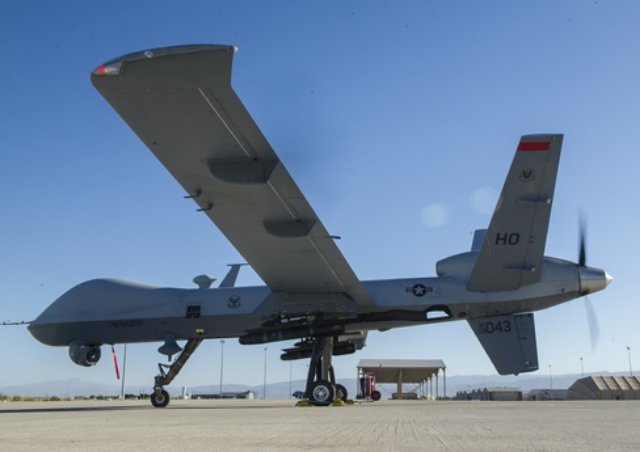An MQ-9 Reaper’s engine design led the drone to crash about 20 minutes after takeoff while deployed overseas in September 2018, a recently released Air Force accident investigation concluded.
Airmen suspected the remotely piloted aircraft, assigned to the 27th Special Operations Wing at Cannon AFB, N.M., and flown by a crew from Creech AFB, Nev., could have suffered “catastrophic engine failure” when a warning message appeared 10 minutes after launching for a mission on Sept. 3, 2018. The crew turned the MQ-9 back toward the airfield to begin dumping fuel, and later saw another warning about the engine’s oil pressure. The RPA pilot decided to land the Reaper, believing the engine could be out.
“Upon touchdown, the propeller failed to go into reverse and the [MQ-9] departed the prepared surface,” the accident report, published Dec. 4, said. “The MQ-9A relies primarily on reverse thrust to slow and stop the aircraft upon landing.”
Even though the aircrew tried to brake, the Reaper needed more energy to stop than its brakes could produce. It left the runway, crashed, and caught fire, destroying the aircraft and four missiles valued at more than $12.7 million in total. No fatalities or private property damage occurred.
“Engineering analysis of the data logs, engine components, and propeller governor, as well as reports from Honeywell Aerospace, Woodward, Inc., and [General Atomics] in this mishap prove, by the preponderance of the evidence, this mishap was caused by the design of the engine installed in the MQ-9A aircraft due to the possibility of failure at higher altitudes and low power settings,” Lt. Col. Ryan Kennedy, who ran the investigation board, wrote in the report.
The Reaper often flies in those conditions during Air Force missions. The 489th Attack Squadron, which handled the aircraft that day, trains aircrews for MQ-9 launches and arrivals and “delivers immediate persistent attack and reconnaissance combat operations in response to emerging base threats,” according to the report.
General Atomics, which builds the MQ-9, declined to answer whether the company is redesigning the engine as a result of the investigation. The Air Force did not answer by press time.
Investigators added that the MQ-9’s brake system design, as well as a delay in collecting and analyzing oil samples, substantially contributed to the accident. An analysis of an oil sample gathered by maintainers on Sep. 2, 2018, “showed evidence of the impending failure of the compressor bearing in the form of metal particles,” but because of a delay in getting the sample from the undisclosed location to the lab, “the aircraft was flown and the compressor bearing failed before action could be taken to correct the impending failure,” states the report.
Neither maintenance issues nor human error contributed to the crash, Kennedy found.
Kennedy said the Air Force Life Cycle Management Center and General Atomics also held up the investigation, which ran from June 10 to Sept. 9, 2019. Their employees could not work with the inquiry “due to their previous contact with the Safety Investigation Board and subsequent access to safety privilege information.” Details trickled out during the investigation, slowing the release of the final report.
Thirty-four MQ-9s were destroyed from fiscal 2009-2019, according to Air Force Safety Center data. The Reaper involved in this accident was one of two destroyed in fiscal 2018.
Source: Air Force Magazine

